

Brian Charboneau
Social Media Lessons B. Charboneau. Bobo Doll experiment (Bandura) Zimbardo- Stanford Prison Experiment Documentary. Stanford Prison Experiment. By Saul McLeod, updated 2020 Purpose of the Study Zimbardo and his colleagues (1973) were interested in finding out whether the brutality reported among guards in American prisons was due to the sadistic personalities of the guards (i.e., dispositional) or had more to do with the prison environment (i.e., situational).
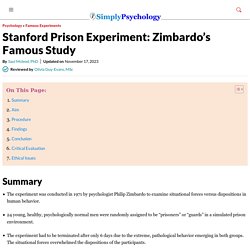
For example, prisoner and guards may have personalities which make conflict inevitable, with prisoners lacking respect for law and order and guards being domineering and aggressive. Alternatively, prisoners and guards may behave in a hostile manner due to the rigid power structure of the social environment in prisons. Zimbardo predicted the situation made people act the way they do rather than their disposition (personality). Procedure To study the roles people play in prison situations, Zimbardo converted a basement of the Stanford University psychology building into a mock prison.
Asch Conformity Experiment. A Class Divided. On the day after Martin Luther King Jr. was murdered in April 1968, Jane Elliott’s third graders from the small, all-white town of Riceville, Iowa, came to class confused and upset.
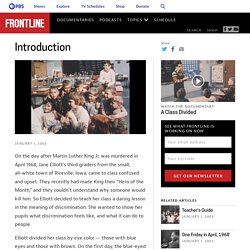
They recently had made King their “Hero of the Month,” and they couldn’t understand why someone would kill him. Brown eyes and blue eyes Racism experiment Children Session - Jane Elliott. Piliavin et al. (1969) Background and Aim: After Kitty Genovese’s murder in New York, Darley and Latané (1968) and Latané and Rodin (1969) conducted a series of experiments that introduced the theory of “bystander apathy” because of the “diffusion of responsibility”.

In other words, a negative event, such as a public attack on a person or a person falling ill on the street and collapsing and needing help, was less likely to result in such help being given if there were many witnesses than if there were few. In fact the fewer the witnesses, the more help was given. If many people saw an attack, for example, each one was likely to believe that others had already called for help, were assisting, or had decided it was not an emergency situation. Milgrim Experiment. Polish scientists replicated the Milgram Experiment, except this time, they included women. Remember that study from psychology class where participants were willing to shock people with excessively high voltage, just because a researcher told them to?
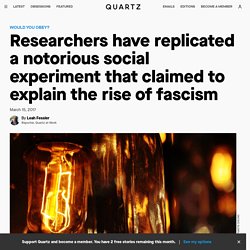
Well, a new paper published March 14 just announced that the famous Milgram Experiment has been replicated in Poland over 50 years since its inception in the US. It’s been replicated before, but this is the first time any effort to do so has involved both men and women in shock-giving and shock-receiving roles. The goal: to evaluate whether participants are more or less likely to shock a woman than a man. The Murder of Kitty Genovese and The Bystander Effect. Chimpanzees Help Each Other upon Request. Abstract Background The evolution of altruism has been explained mainly from ultimate perspectives.

Cognitive Dissonance Comic. Real-Life Examples of Cognitive Dissonance. To get a clear picture of what cognitive dissonance is, it helps to first grasp what happens when that tension (or “dissonance”) occurs.

Corrine Leikam, PsyD, an associate director at Sober College, an addiction and counseling program in Los Angeles, says our instinctive reaction is to try to resolve the conflict and bring stability back to our lives. Oftentimes, this happens in your mind without needing to actively think about it. “Once we become aware of the mental and emotional discomfort cognitive dissonance causes, it’s often a quick and instantaneous next step to reduce the dissonance in some manner,” Noulas says.
You may simply adjust the importance of one idea, belief, or attitude so it’s less dissonant, she says. In the spilled coffee example, you quickly talk yourself out of the anger you initially feel by telling yourself there’s no practical reason to be angry because you can quickly replace the coffee at little cost to you.
The Social Facilitation Effect. Social Psych Skits. To Help or Not To Help? - The Psychology Notes Headquarters. In 1964, a woman named Kitty Genovese was attacked by a man near an apartment in New York.
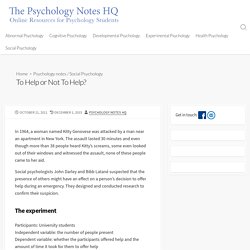
The assault lasted 30 minutes and even though more than 38 people heard Kitty’s screams, some even looked out of their windows and witnessed the assault, none of these people came to her aid. Social psychologists John Darley and Bibb Latané suspected that the presence of others might have an effect on a person’s decision to offer help during an emergency. They designed and conducted research to confirm their suspicion. The experiment Participants: University students Independent variable: the number of people present Dependent variable: whether the participants offered help and the amount of time it took for them to offer help The university students were told that they were participating in a discussion about personal problem associated with school. What if you could trade a paperclip for a house? Advocating for the Homeless. Project Implicit. Would You Stop a Hate Crime in Progress? March 14, 2009— -- Jose Sucuzhanay was walking home from a party in Brooklyn, N.Y., last December when two strangers attacked him with an aluminum bat.
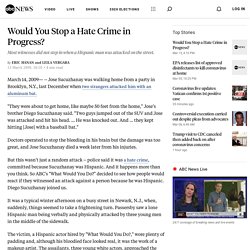
"They were about to get home, like maybe 50 feet from the home," Jose's brother Diego Sucuzhanay said. Aggressiveness Questionnaire. Social Psych Classroom Assignment. Social Psychology Flashcards. Volunteers for Community Impact – Impacting Your Community.